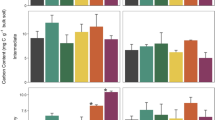Abstract
We investigated the role of water-extractable carbon (C-extr) as potential substrate for forest soil microorganisms by comparing belowground C fluxes at a plot with the forest floor removed (no-litter) and at a control plot. One-third lower soil respiration rates at the no-litter plot gave evidence that the forest floor was the source of considerable amounts of microbially degradable C. Laboratory incubation of C-extr, fractionated into neutral and acid moieties, showed that part of the C-extr was degraded rapidly, and that the high-molecular-weight acid fraction was much less degradable than the neutral C. To the extent that the degradable portion of the water-extractable C can be regenerated quickly, it may supply much of the substrate for heterotrophic soil respiration.
Similar content being viewed by others
Author information
Authors and Affiliations
Additional information
Received: 11 December 1995
Rights and permissions
About this article
Cite this article
Jandl, R., Sollins, P. Water-extractable soil carbon in relation to the belowground carbon cycle. Biol Fertil Soils 25, 196–201 (1997). https://doi.org/10.1007/s003740050303
Issue Date:
DOI: https://doi.org/10.1007/s003740050303




